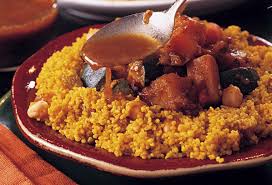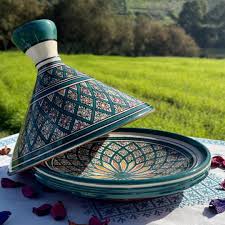Exploring the Delights of a Typical Moroccan Meal
Moroccan cuisine is a vibrant tapestry of flavours, aromas, and textures that reflect the country’s rich history and diverse cultural influences. A typical Moroccan meal is not just about satisfying hunger; it’s a sensory experience that immerses you in the traditions and hospitality of this North African nation.
The Art of Sharing
In Morocco, meals are often enjoyed with family and friends, emphasizing the importance of communal dining. A typical Moroccan meal starts with small plates of appetizers, such as olives, bread, and salads, followed by the main course.
Tagine: The Heart of Moroccan Cuisine
No discussion of Moroccan food is complete without mentioning tagine. This iconic dish consists of slow-cooked meat or vegetables stewed with aromatic spices in a conical clay pot. The result is tender, flavourful dishes that tantalize the taste buds.
Couscous: A Staple Grain
Couscous is another cornerstone of Moroccan cuisine. This fluffy semolina grain serves as a versatile base for savoury stews made with meat, vegetables, and chickpeas. The delicate texture of couscous complements the bold flavours of Moroccan spices perfectly.
Moroccan Mint Tea: A Refreshing Finale
To conclude a meal in true Moroccan fashion, indulge in a steaming glass of sweet mint tea. This traditional beverage is not only a palate cleanser but also a symbol of hospitality and warmth in Moroccan culture.
Final Thoughts
A typical Moroccan meal is more than just food; it’s an expression of tradition, community, and hospitality. From the intricate blend of spices to the artful presentation on colourful plates, every aspect of dining in Morocco tells a story steeped in centuries-old customs and culinary expertise.
Exploring Moroccan Cuisine: Answers to 7 Common Questions About Traditional Meals
- What is a typical Moroccan meal like?
- What are the key components of a traditional Moroccan dish?
- How is tagine prepared in Moroccan cuisine?
- What spices are commonly used in Moroccan cooking?
- Is couscous a staple in Moroccan meals?
- What beverages complement a typical Moroccan meal?
- Are there any vegetarian options available in Moroccan cuisine?
What is a typical Moroccan meal like?
A typical Moroccan meal is a sensory journey through the vibrant flavours and rich traditions of North African cuisine. It often begins with a spread of appetizers like olives, bread, and salads, setting the stage for the main event. The heart of a Moroccan meal lies in dishes cooked in a tagine—a clay pot that infuses meat or vegetables with aromatic spices, resulting in tender and fragrant creations. Accompanied by fluffy couscous and sweet mint tea to cleanse the palate, dining in Morocco is not just about sustenance but an immersive experience that celebrates community, hospitality, and the art of culinary storytelling.
What are the key components of a traditional Moroccan dish?
In exploring the key components of a traditional Moroccan dish, one immediately encounters a symphony of flavours and textures that define the culinary landscape of Morocco. At the heart of a typical Moroccan meal lies the iconic tagine, a slow-cooked stew bursting with tender meat or vegetables infused with aromatic spices. Complementing this main feature is couscous, a fluffy semolina grain that serves as a versatile base for savoury stews rich in meat, vegetables, and legumes. The vibrant array of ingredients includes preserved lemons, olives, almonds, and an assortment of fragrant spices like cumin, cinnamon, and saffron. Each element plays a crucial role in creating the harmonious balance of sweet, savoury, and tangy flavours that characterise traditional Moroccan cuisine.
How is tagine prepared in Moroccan cuisine?
In Moroccan cuisine, preparing tagine is a culinary art that involves slow-cooking meat, vegetables, and aromatic spices in a conical clay pot called a tagine. The method of cooking in a tagine allows the ingredients to simmer and stew gently, resulting in tender and flavourful dishes. The combination of spices such as cumin, paprika, cinnamon, and saffron infuses the dish with a rich and complex flavour profile that is characteristic of Moroccan cuisine. The unique shape of the tagine pot helps to circulate steam and retain moisture, ensuring that the ingredients are cooked to perfection. Tagine preparation in Moroccan cuisine is not just about creating a meal; it’s a time-honoured tradition that brings families together around the dinner table to savour the delicious results of this iconic dish.
What spices are commonly used in Moroccan cooking?
In Moroccan cooking, a vibrant array of spices plays a central role in creating the distinctive flavours that define the cuisine. Commonly used spices include cumin, coriander, cinnamon, paprika, turmeric, ginger, and saffron. Each spice brings its own unique depth and complexity to dishes such as tagines, couscous, and pastillas. The artful combination of these aromatic spices is what gives Moroccan cuisine its rich and exotic taste profile, enticing food enthusiasts from around the world to savour the culinary delights of this North African gem.
Is couscous a staple in Moroccan meals?
Couscous holds a revered status as a staple in Moroccan meals, playing a central role in the country’s culinary traditions. This fluffy semolina grain is not just a side dish but often forms the foundation of hearty and flavourful stews that are enjoyed across Morocco. The versatility of couscous allows it to be paired with various ingredients such as tender meats, seasonal vegetables, and aromatic spices, creating a harmonious blend of textures and tastes that define the essence of Moroccan cuisine. Whether served at festive gatherings or everyday family meals, couscous embodies the cultural significance and culinary artistry deeply rooted in Moroccan gastronomy.
What beverages complement a typical Moroccan meal?
In Morocco, a typical meal is often accompanied by a variety of beverages that enhance the flavours and overall dining experience. One popular choice is Moroccan mint tea, known for its refreshing taste and cultural significance as a symbol of hospitality. This sweet and fragrant tea pairs well with the bold spices and rich dishes of Moroccan cuisine, offering a soothing contrast to the hearty flavours. Additionally, fresh fruit juices, such as orange or pomegranate juice, are commonly served to add a burst of sweetness to the meal. For those seeking a non-alcoholic option, these traditional beverages perfectly complement the diverse flavours of a typical Moroccan feast.
Are there any vegetarian options available in Moroccan cuisine?
In Moroccan cuisine, there are abundant vegetarian options that showcase the country’s diverse array of flavours and ingredients. From hearty vegetable tagines bursting with spices to fragrant couscous dishes brimming with seasonal produce, vegetarians can savour a rich tapestry of tastes in Moroccan gastronomy. The culinary tradition also includes a variety of mezze-style appetisers, salads, and soups that cater to vegetarian preferences, offering a delightful exploration of meat-free dining experiences within the vibrant and colourful world of Moroccan food.




